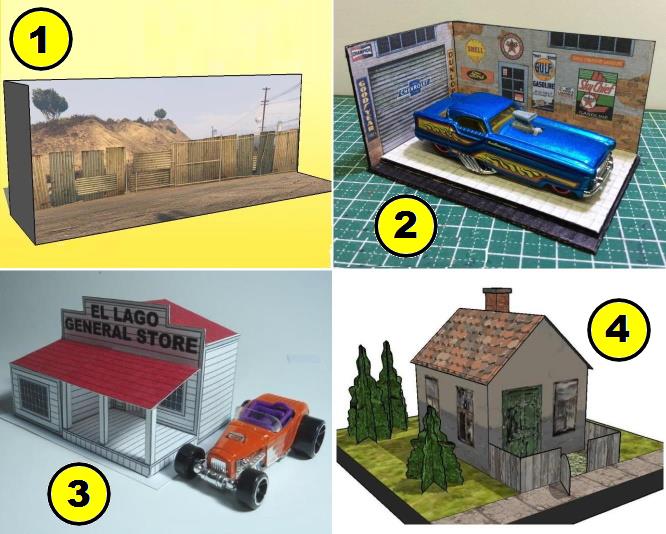Keisuke Saka, born in Toyama Prefecture, in Tokyo, Japan, is a talented paper engineer and graphic designer who has been offering us his beautiful and very original paper creations since 1994.
If you visit or assemble papercrafts on the Canon website, you've probably seen or assembled something by Mr. Saka.
This papercraft of Toshiie Maeda's golden armor was created by Mr. Saka exclusively for the website of IO Data, a prestigious electronics manufacturer, and showcases the technical quality of this brilliant Japanese designer.
The entire model occupies just three printed pages and the instructions are clear, very well illustrated and will leave no doubts for anyone interested in assembling this legendary armor.
Toshiie Maeda (1538-1599) was one of Toyotomi Hideyoshi's most loyal and important generals, one of the most prominent figures of the Sengoku period in Japan and is widely recognized as the unifier of the country after more than a century of conflicts and civil wars.
Maeda stood out as one of the "Five Great Elders" responsible for governing Japan after Hideyoshi's death. He began his military career serving under Oda Nobunaga and later transferred his allegiance to Hideyoshi after Nobunaga's death.
Toshiie is best known as the founder of the Maeda family, which ruled Kaga Domain, one of the largest and richest provinces in feudal Japan. Under his leadership, the Kaga domain prospered economically and culturally.
His loyalty and administrative skills ensured the stability of the region and strengthened the position of his family, which maintained control over Kaga for several generations.
Toshiie is remembered as one of the great daimyo of the Sengoku period. Toshiie Maeda's golden armor is one of the most famous and distinctive armors from the Sengoku period in Japan.
Known for its impressive appearance, this armor was decorated with golden details that symbolized Toshiie's power and wealth. Made from high-quality materials and with meticulous attention to detail, the armor not only provided effective protection in combat, but also demonstrated Toshiie's high status and importance as one of Toyotomi Hideyoshi's top lords.
The use of gold in armor served both to inspire his allies and to intimidate his enemies, highlighting Toshiie Maeda as one of the great daimyo of his time.
The armor is currently on display at the Maeda Toshiie and Omatsu Museum in Kanazawa, Ishikawa Prefecture, Japan.
This museum is dedicated to preserving the history and artifacts related to the Maeda family, who ruled Kaga Domain for many generations.
The armor is a centerpiece of the museum's collection and attracts many visitors interested in learning about the history and culture of the Sengoku period.
On the same page you will find some more Japanese-themed papercrafts, as can be seen in the last image of this post.
Keisuke Saka, natural da província de Toyama, em Tóquio, Japão, é um talentoso engenheiro de papel e designer gráfico que desde 1994 nos brinda com suas belas e muito originais criações em papel.
Se você é visita ou monta os papercrafts do site da Canon, provavelmente já viu ou montou algo do Sr. Saka.
Este papercraft da armadura dourada de Toshiie Maeda foi criado pelo Sr. Saka exclusivamente para o site da IO Data, uma prestigiada fabricante de produtos eletrônicos, e mostra a qualidade técnica deste brilhante designer japonês.
O modelo todo ocupa apenas três folhas impressas e as instruções são claras, muito bem ilustradas e não deixarão dúvidas para todos aqueles que se interessarem em montar essa lendária armadura.
Toshiie Maeda (1538-1599) foi um dos mais leais e importantes generais de Toyotomi Hideyoshi, uma das figuras mais proeminentes do período Sengoku no Japão e é amplamente reconhecido como o unificador do país após mais de um século de conflitos e guerras civis.
Maeda destacou-se como um dos "Cinco Grandes Anciãos" responsáveis por governar o Japão após a morte de Hideyoshi.
Ele começou sua carreira militar servindo a Oda Nobunaga e depois transferiu sua lealdade para Hideyoshi após a morte de Nobunaga.
Toshiie é mais conhecido como o fundador da família Maeda, que governou o domínio de Kaga, uma das maiores e mais ricas províncias do Japão feudal. Sob sua liderança, o domínio Kaga prosperou economicamente e culturalmente.
Sua lealdade e habilidades administrativas garantiram a estabilidade da região e fortaleceram a posição de sua família, que manteve o controle sobre Kaga por várias gerações. Toshiie é lembrado como um dos grandes daimyo do período Sengoku.
A armadura dourada de Toshiie Maeda é uma das armaduras mais famosas e distintivas do período Sengoku no Japão. Conhecida pela sua impressionante aparência, essa armadura era decorada com detalhes dourados que simbolizavam o poder e a riqueza de Toshiie.
Feita de materiais de alta qualidade e com uma atenção meticulosa aos detalhes, a armadura não só fornecia proteção eficaz em combate, mas também demonstrava o status elevado e a importância de Toshiie como um dos principais senhores de Toyotomi Hideyoshi.
A utilização de ouro na armadura servia tanto para inspirar seus aliados quanto para intimidar seus inimigos, destacando Toshiie Maeda como um dos grandes daimyo de seu tempo. A armadura está atualmente em exibição no Museu Maeda Toshiie e Omatsu em Kanazawa, na prefeitura de Ishikawa, Japão.
Este museu é dedicado a preservar a história e os artefatos relacionados à família Maeda, que governou o domínio de Kaga por muitas gerações.
A armadura é uma peça central da coleção do museu e atrai muitos visitantes interessados em aprender sobre a história e a cultura do período Sengoku.
Na mesma página você vai encontrar mais alguns papercrafts com temática japonesa, como pode ser visto na imagem logo abaixo.




























